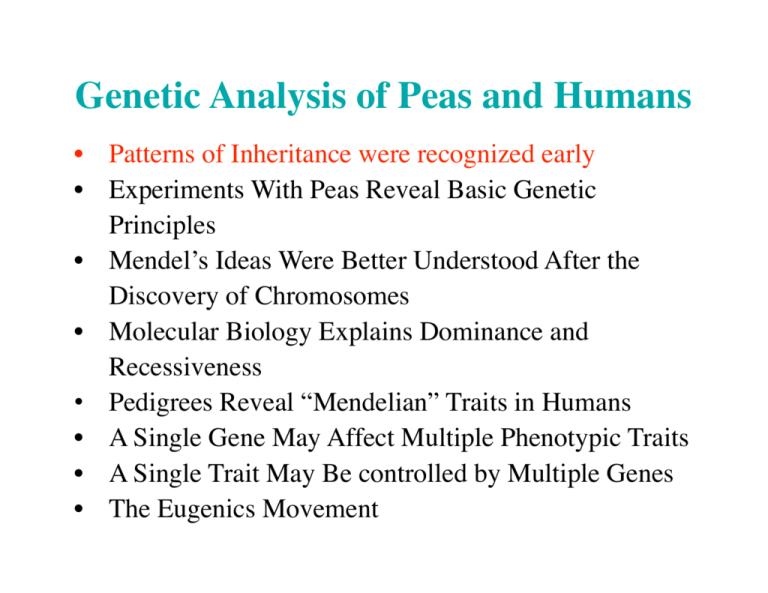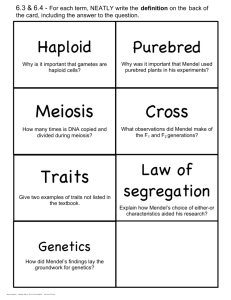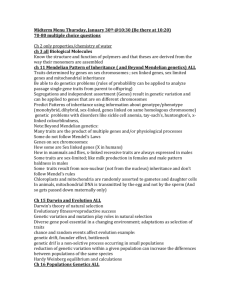Genetic Analysis of Peas and Humans
advertisement

Genetic Analysis of Peas and Humans • Patterns of Inheritance were recognized early • Experiments With Peas Reveal Basic Genetic Principles • Mendel’s Ideas Were Better Understood After the Discovery of Chromosomes • Molecular Biology Explains Dominance and Recessiveness • Pedigrees Reveal “Mendelian” Traits in Humans • A Single Gene May Affect Multiple Phenotypic Traits • A Single Trait May Be controlled by Multiple Genes • The Eugenics Movement Gregor Mendel He pioneered the study of genetics in the 1850s with crossing experiments on garden peas Genetic Analysis of Peas and Humans • Patterns of Inheritance were recognized early • Experiments With Peas Reveal Basic Genetic Principles • Mendel’s Ideas Were Better Understood After the Discovery of Chromosomes • Molecular Biology Explains Dominance and Recessiveness • Pedigrees Reveal “Mendelian” Traits in Humans • A Single Gene May Affect Multiple Phenotypic Traits • A Single Trait May Be controlled by Multiple Genes • The Eugenics Movement Pea characteristics studied by Mendel Mendel chose for study only characteristics that occurred as two distinct traits, such as flower color: purple or white, with no intermediates Mendel’s technique for crosspollinating flowers from different pea varieties Smooth x Wrinkled Mendel crossed two pea varieties with different seed shapes: smooth and wrinkled. While the F1 generation had all smooth seeds, the wrinkled trait reappeared in 25% of the F2 generation. He concluded that individuals must carry two versions of the hereditary “factor” controlling each trait. Cummings M.R. (2006) Meiosis Campbell & Reece (2002) This diagram represents only one pair of homologous chromosomes. Meiosis I is unusual because the two homologs from each pair are segregated into different daughter cells. (This is not so in mitosis.) Principle of segregation, Punnett square Can you spot an error in part (b) near the top? From Campbell and Reece (2001) Genetic Analysis of Peas and Humans • Patterns of Inheritance were recognized early • Experiments With Peas Reveal Basic Genetic Principles • Mendel’s Ideas Were Better Understood After the Discovery of Chromosomes • Molecular Biology Explains Dominance and Recessiveness • Pedigrees Reveal “Mendelian” Traits in Humans • A Single Gene May Affect Multiple Phenotypic Traits • A Single Trait May Be controlled by Multiple Genes • The Eugenics Movement Chromosomes in a plant cell Pairs of Homologous Chromosomes In most organisms, chromosomes exist in pairs of two homologs, one derived from the paternal parent and the other from the maternal parent. Except for the sex chromosomes, homologs have similar versions (alleles) of the same genes. Error: Lac/lac refers to the gene for lactase, not lactose. Separation of Homologs During Meiosis I Campbell & Reece (2002) This diagram tracks just one pair of homologous chromosomes. The first meiotic division separates the homologs of each pair, thus reducing the chromosome number from 2n per diploid cell to n per gamete. Genetic Analysis of Peas and Humans • Patterns of Inheritance were recognized early • Experiments With Peas Reveal Basic Genetic Principles • Mendel’s Ideas Were Better Understood After the Discovery of Chromosomes • Molecular Biology Explains Dominance and Recessiveness • Pedigrees Reveal “Mendelian” Traits in Humans • A Single Gene May Affect Multiple Phenotypic Traits • A Single Trait May Be controlled by Multiple Genes • The Eugenics Movement Incomplete Dominance of Flower Color in Snapdragon When red and white snapdragons are crossed, the F1 generation has pink flowers. In peas, the equivalent cross had a different result. Cummings M.R. (2006) Principle of segregation, Punnett square Campbell and Reece (2001) In snapdragon, the F1 and half of the F2 of a red x white cross have pink flowers. These plants have only one functional allele, R, of a gene encoding an enzyme required for making the red flower pigment. Two copies of R are necessary to make enough pigment for red flowers. In peas, half the normal dosage of an analogous gene (P) is enough to make adequate amounts of the purple flower pigment, so that PP and Pp genotypes produce the same phenotype. Codominant Expression of Blood Antigens Cummings M.R. (2006) The major human blood antigens (A and B) are encoded by a gene located on chromosome 9 that exists in three alleles. Allele IA encodes antigen A, allele IB encodes antigen B, and allele IO encodes no antigen. Genetic Analysis of Peas and Humans • Patterns of Inheritance were recognized early • Experiments With Peas Reveal Basic Genetic Principles • Mendel’s Ideas Were Better Understood After the Discovery of Chromosomes • Molecular Biology Explains Dominance and Recessiveness • Pedigrees Reveal “Mendelian” Traits in Humans • A Single Gene May Affect Multiple Phenotypic Traits • A Single Trait May Be controlled by Multiple Genes • The Eugenics Movement Brachydactyly Type BDA2 (OMIM 112600) Photos and radiograph show hands or feet of the individuals marked with capital letters in the following pedigree. Brachydactyly Type BDA2 (OMIM 112600) Pedigrees of two human families with brachydactyly type BDA2. Circle represent females, squares males. Filled symbols indicate disease phenotype. The pedigrees indicate that brachydactyly is a dominant autosomal disorder. Capital letters mark the individuals photographed in the preceding slide. Albinism (OMIM 203100) Albinism is caused by the lack of pigment in skin, hair, and the retina of the eye. Typically, it is a recessive autosomal disorder, caused by mutations in the gene for tyrosinase, an enzyme involved in the synthesis of the black pigment melanin. Cummings M.R. (2006) Segregation of Albinism In humans as in pea plants, homologous alleles for albinism segregate during gamete formation. As a recessive autosomal disorder, it shows up in 25% of the offspring of a heterozygous pair, even though both parents are phenotypically normal. Cummings M.R. (2006) Red-green Color Blindness Red-green color blindness is an X-linked recessive trait. In this pedigree, Xn = normal X chromosome, Xp = X chromosome causing phenotype Hemophilia and History Cummings M.R. (2006) Hemophilia (faulty blood clotting) is an X-linked recessive disorder. Queen Victoria of England was its most prominent carrier. Genetic Analysis of Peas and Humans • Patterns of Inheritance were recognized early • Experiments With Peas Reveal Basic Genetic Principles • Mendel’s Ideas Were Better Understood After the Discovery of Chromosomes • Molecular Biology Explains Dominance and Recessiveness • Pedigrees Reveal “Mendelian” Traits in Humans • A Single Gene May Affect Multiple Phenotypic Traits • A Single Trait May Be controlled by Multiple Genes • The Eugenics Movement Marfan Syndrome Reveals Pleiotropic Gene Cummings M.R. (2006) Marfan syndrome is a dominant autosomal disorder of the gene for fibrillin, a key protein in fibrous connective tissue. Affected people are tall but tend to have various abnormalities in their connective tissues, including dilated blood vessels prone to rupture. Antagonistic Pleiotropy of Mutant ß-Globin Alleles Genetic Analysis of Peas and Humans • Patterns of Inheritance were recognized early • Experiments With Peas Reveal Basic Genetic Principles • Mendel’s Ideas Were Better Understood After the Discovery of Chromosomes • Molecular Biology Explains Dominance and Recessiveness • Pedigrees Reveal “Mendelian” Traits in Humans • A Single Gene May Affect Multiple Phenotypic Traits • A Single Trait May Be controlled by Multiple Genes • The Eugenics Movement Polygenic Inheritance of Skin Pigmentation According to the hypothesis shown here, three separate genes affect the amount of skin pigment independently. Each dominant allele is thought to contribute one “unit” of pigmentation in an additive way. The Punnett square shows the seven classes of skin pigmentation that would result. Genetic Analysis of Peas and Humans • Patterns of Inheritance were recognized early • Experiments With Peas Reveal Basic Genetic Principles • Mendel’s Ideas Were Better Understood After the Discovery of Chromosomes • Molecular Biology Explains Dominance and Recessiveness • Pedigrees Reveal “Mendelian” Traits in Humans • A Single Gene May Affect Multiple Phenotypic Traits • A Single Trait May Be controlled by Multiple Genes • The Eugenics Movement Eugenics Movement Cummings M.R. (2006) To advocate governmental control of human procreation, eugenicists set up exhibits and gave lectures at public events. Pleiotropy, Polygeny & Environment Many human genes affect multiple traits (pleiotropy), while many human traits are affected by several genes (polygeny). In addition to genes, environmental factors contribute to human traits and may influence natural selection. Genetic Analysis of Peas and Humans • Patterns of Inheritance were recognized early • Experiments With Peas Reveal Basic Genetic Principles • Mendel’s Ideas Were Better Understood After the Discovery of Chromosomes • Molecular Biology Explains Dominance and Recessiveness • Pedigrees Reveal “Mendelian” Traits in Humans • A Single Gene May Affect Multiple Phenotypic Traits • A Single Trait May Be controlled by Multiple Genes • The Eugenics Movement Marfan heart Cummings M.R. (2006) Mendel’s rules of “segregation” and “independent assortment” explain the results of dihybrid crosses.







